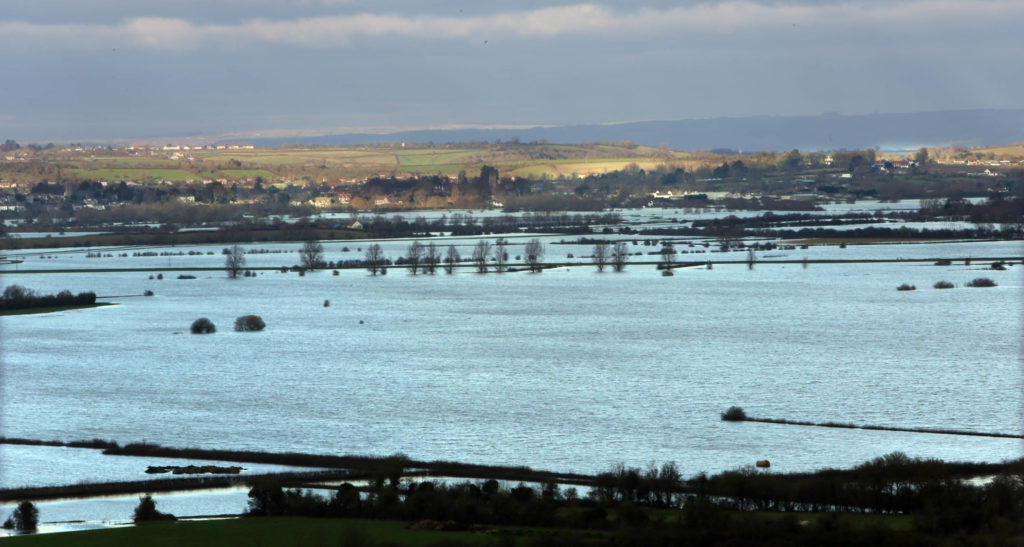This winter marks ten years since the wettest winter for 250 years left large swathes of the county underwater for weeks, devastating communities, businesses and farming.
February 4, 2014, saw the then Prince of Wales escorted through flood waters to the cut-off village Muchelney to meet residents and farmers.
The following day, two severe flood warnings were issued for parts of the Somerset Levels, with residents in several villages advised to evacuate and Royal Marines deployed to help reinforce flood defences at Burrowbridge.
Much flood defence and risk management work has taken place since 2014, at a cost of around £80m as part of a 20-Year Flood Action Plan (FAP) delivered by local authorities, the Environment Agency (EA), the Parrett and Axe Brue Internal Drainage Boards which are all part of the Somerset Rivers Authority (SRA) partnership set up to give Somerset an extra level of flood protection.
Work has included:
- the award-winning raising of a 500-metre section of a road into Muchelney
- dredging stretches of the River Parrett
- enhancements to the River Sowy and King’s Sedgemoor Drain system, for example with new river channels under the A372 at Beer Wall near Othery
- development of plans for a Bridgwater Tidal Barrier
- hundreds of natural flood management works to ‘Slow the Flow’ of water as part of Hills to Levels.
As a result, even though this winter has been the wettest since records began in 1910, the areas devastated in 2014 have not been badly affected. More flood risk management works are planned and the SRA is currently developing a new Strategy and Flood Action Plan for the next ten years.
However, across Somerset, the impacts of climate change mean that resilience and adaptation to flood risk will need to play a bigger part in Somerset’s future.
The major flooding incident at the start of 2014 flooded 165 homes, mostly on the Levels and Moors, lasting weeks in many cases.
Between May 2023 and the end of January this year, almost double that number of homes across the county flooded as a result of four storm events, the most recent being Storm Henk in January.
Although the more recent flooding has been shorter-lived, flash flooding, the last year has demonstrated the need for resilience and adaptation as climate change increases the frequency and severity of weather events.
Councillor Dixie Darch, Somerset Council’s Lead Member for Environment and Climate Change and SRA Board member, said:
A lot of hard work has gone into reducing flood risk and managing the impacts since the devastating scenes we saw ten years ago.
We’ve seen progress, but clearly flooding remains an issue that Somerset will have to live with as the impacts of climate change become apparent.
All the science tells us that weather events like the storms we have seen in the last 12 months are likely to become more common and more severe.
That means organisations and communities must work in partnership to build resilience and adapt to the challenges of flooding.”
Cllr Mike Stanton, Chair of Somerset Rivers Authority, said:
All the investment that has been made across Somerset over the last decade has reduced the risks and impacts of flooding.
Through the SRA, more funding will continue to be given for protective maintenance and improvement works that enable more safety, control and useful flexibility in the management of water systems.
But we have to acknowledge that flood risks can never be completely removed and that places are now being affected in unexpected ways. We will all need to become more resilient and adapt to a changing climate.
Resilience is about communities understanding the risk of flooding and being well prepared, for example signing up for flood alerts, identifying flood wardens and being ready with practical steps like flood evacuation plans.
Adaptation is about making changes that help limit the impacts of flooding if it does happen, for example raising electrical sockets and having water butt storage to help reduce flash flooding.
The Somerset Prepared multi-agency partnership works with communities to provide advice, support and training to help improve local resilience to all kinds of emergencies, including flooding.
To find out more visit www.somersetprepared.org.uk.
As part of its plans, the SRA is proposing to fund a new project called Adapting Somerset. Run by Somerset Wildlife Trust, it would help adapt and increase resilience to flooding and other risks linked to climate change in Somerset.
For information and guidance about flooding in Somerset, including being prepared, and what to do during and after flooding, visit somerset.gov.uk/flooding.
For information about the SRA and its work, visit somersetriversauthority.org.uk.

